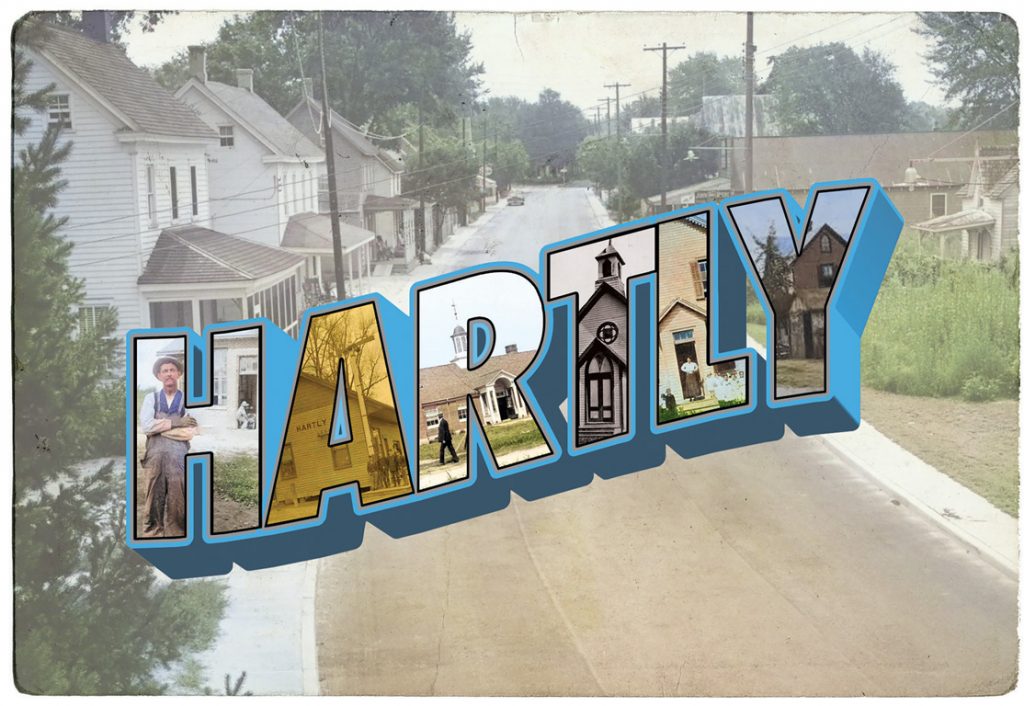Join us for December's First Saturday Program: A County Divided – Loyalists, Patriots, and the Revolutionary Experience in Sussex County.
More Info


The 1868 Beers Atlas of Delaware shows a settlement called Arthursville in western Kent County where the road from Dover intersected the Maryland and Delaware Railroad line. The village was re-named Hartly for a Mr. Hart, a railroad employee, who was instrumental in bringing the railroad to the area. The rail line was laid in the 1850s with the first depot located a half mile south of Hartly at Slaughter Station. By 1882, Hartly seemed more likely to develop into a Town. It already had a store, a church, a schoolhouse, a post office and a number of houses and would soon have a hotel. This prompted the railroad to relocate the rail station there where is better served both the farming community and drew passengers. Unfortunately, by the mid-twentieth century, passenger service on the rail line was abandoned and freight service would soon follow. Today, Hartly is Delaware’s smallest town in both population and area.
The village of Hartly was first incorporated in 1917 as “The Commissioners of Hartly.” The boundaries of the village are defined in the 1917 Act. The village was to be governed by three Commissioners elected to one-year terms. A President was to be chosen from among the Commissioners who would preside over their four yearly meetings, have general supervision over the streets, and of any person employed by the Commissioners as well as receive complaints from citizens and present these to the Commissioners. The Commissioners were to enact ordinances for the good government of the village; light and improve the streets (assisted by an annual allocation of $200 from Kent County); pave and improve the sidewalks (at the expense of the adjacent property owner); plant and protect ornamental trees; repair and make public pumps; impose fines and levy taxes. Taxes were to be assessed against real estate and personal property in addition to a per capita tax against all males above the age of 21 years. All machinery within a factory was exempt from taxation. The maximum tax to be levied on the village annually was not to exceed $300. Town officials included an Assessor, Tax Collector, Treasurer, Clerk, Alderman, and Constable. It was the duty of the Alderman and Constable to suppress all riotous, turbulent, disorderly or noisy assemblages or gatherings of persons in the village and to generally keep the peace.1
In the time between its incorporation and its reincorporation sixty-six years later, the 1917 Incorporating Act was amended only five times. In 1927, ten years after its incorporation, Hartly was authorized to borrow $500 with which to install electric lights; bonds were to be issued but no referendum was required.2 In 1931, the 1917 Act was revised by amending the Town’s boundaries.3 In 1933, the maximum amount of taxation annually was increased to $500.4 In 1937, the date of the election was changed from March to April.5
In 1955, the amount of taxes to be levied was increased again, to $1,000 annually.6 Hartly was re-incorporated in 1983 as the “Town of Hartly,” and a Charter was established. The Town limits matched those in the 1931 law which expanded the boundaries; further expansion of contiguous territory was authorized and procedures for this were outlined in the Act. The Charter called for the election of five Commissioners to be elected to two-year terms by voters who are residents of Hartly, over 18 years of age, and current in paying their taxes. The Commissioners were to choose one of their members to serve as President. The President presided over Commission meetings which must be held at least four times a year. Appointed Town officials included a Treasurer, Town Clerk, Town Solicitor, and Public Works/Building Inspector. The Commissioners were authorized with certain corporate powers among which are: to hold, purchase, lease or sell real property for any municipal purpose; to grant options to purchase or renew a lease for any Town project; to abate, demolish and remove dangerous buildings and structures including the power to condemn and tear down if determined to be a fire hazard; to purchase and hold real and personal property for any delinquent tax, assessment, water rent, electric bill, license fee, tapping fee, or other charge for a municipal service and to sell the same; to make improvements on property which it owns; to regulate and control the manner of building by granting building permits; to adopt zoning ordinances; to enter into contracts which are in the best interest of the Town; to contract for professional services; to procure and keep in force adequate insurance to protect the Town’s property; and to contract with any government or agency for cooperation in the maintenance and operation of police, trash collection or other municipal service. The Commissioners control the streets, sidewalks, street drainage, and street lighting. In addition, at such time as it was determined to be in the best interest of the Town, the Commissioners were authorized to install and maintain a sewer system. The annual maximum level of taxation for the Town was not to exceed 50% of the total assessed value to all real estate. The Town was authorized to borrow money in anticipation of revenue of up to $10,000 in any one year; however, with referendum approval, may borrow above this amount, but no more than $200,000, in aggregate.7
For the fully amended text of the current Charter, see http://www.charters.delaware.gov/hartly.shtml
CITATIONS in Del. Laws
1 29 Del. Laws, c. 152 (1917) [pp. 479-86]
2 35 Del. Laws, c. 110 (1927) [pp. 336-37]
3 37 Del. Laws, c. 159 (1931) [pp. 555-56]
4 38 Del. Laws, c. 103 (1933) [p. 436]
5 40 Del. Laws, c. 149 (1937) [p. 439]
6 50 Del. Laws, c. 23 (1955) [p. 47]
7 64 Del. Laws, c. 210 (1983) [pp. 510-23]
Delaware Laws from 1935 to present can be found online at http://delcode.delaware.gov/sessionlaws/
jnl / April 5, 2019